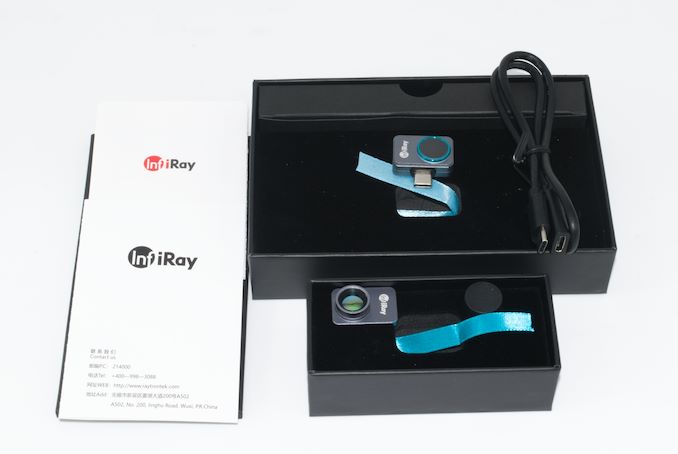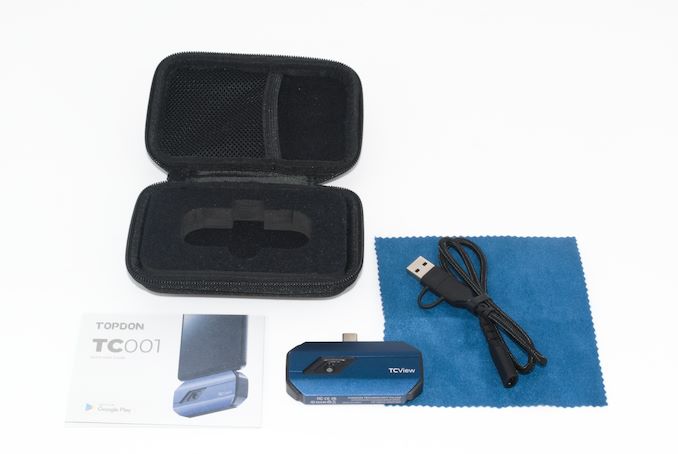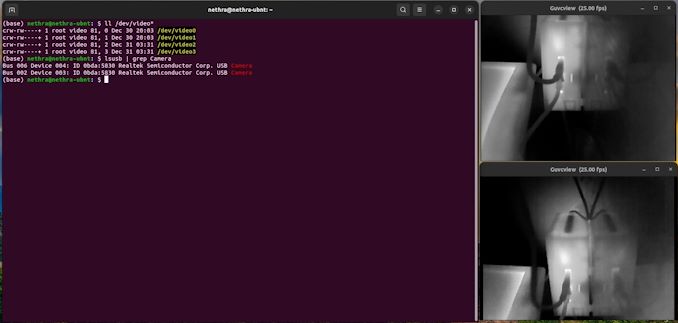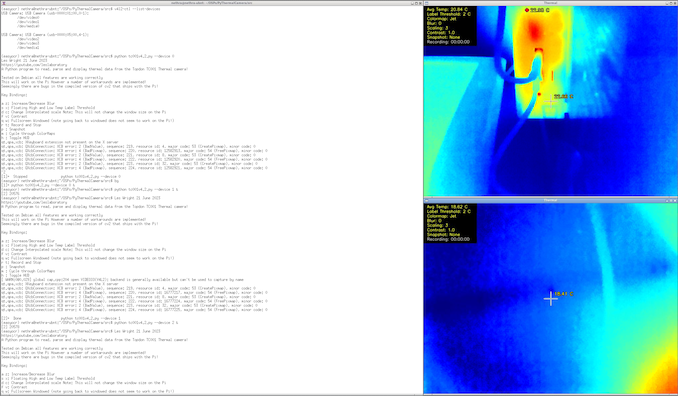InfiRay P2 Pro and TOPDON TC001 Thermal Cameras Capsule Review
by Ganesh T S & Nethra Iyler on December 31, 2023 9:45 AM EST- Posted in
- Gadgets
- Thermal Imaging
- InfiRay

The consumer thermal camera market was opened up in the late 2010s by the launch of Seek Thermal's first offering and FLIR's FLIR ONE / FLIR ONE Pro. These had comparatively high resolutions of 206x156 and 160x120, which allowed the companies to further cut down the cost of follow-up products with lower-resolution sensors. US regulations prevent these cameras from offering videos with frame rates higher than 9 Hz, but that is often plenty enough for a wide variety of consumer use-cases such as home inspection (both electrical and plumbing), rodent control etc. The last couple of years have seen a new crop of thermal cameras from Asian vendors that don't seem to be subject to frame rate limitations. Two vendors - InfiRay and TOPDON - reached out with review samples of their consumer-focused smartphone-attachable thermal cameras. This capsule review provides a comparative look at the features of the InfiRay P2 Pro and the TOPDON TC001, with a focus on the user experience aspect.
Introduction and Product Impressions
InfiRay is the brand name under which products manufactured by IRay Technology Co. are being marketed. The company has been in operation for the last decade and claims many patents related to thermal imaging. The company designs and manufactures its own thermal imaging sensors using microbolometer infrared focal plane array technology. The basics of microbolometer sensors have already been covered in our previous thermal camera reviews, and are not being repeated here.
The P2 Pro is an ultra-compact smartphone-attachable thermal imager with a 256x192 resolution. It sports a Type-C male interface, and measures just 9g in weight. The temperature measurement range is from -4F to 1112F. It can record videos at up to 25 Hz. InfiRay claims an operational power consumption of less than 400 mW. The product also includes a magnetic macro lens that allows thermal investigation of minute components such as those on a circuit board. An extension cable (Type-C female to Type-C male) is also provided for flexibility in image capture.
TOPDON is a vendor of automotive equipment including ADAS packages, battery tools, EV chargers, and diagnostic tools (including thermal cameras). It is much larger than the InfiRay P2 Pro, but has the same IR resolution of 256x192. It weighs 30g, and measures 71mm x 42mm x 14mm. The temperature measurement range is from -4F to 1022F. Included in the package is a 50cm USB cable with a Type-C female port at one end, and a Type-C male with an attached Type-C female to Type-A male adapter.
While both the P2 Pro and the TOPDON TC001 have their own Android applications, TOPDON also provides the Windows-based TCView application for image / video capture and analysis.
| Smartphone-Attached Thermal Cameras Specifications | ||||
| Aspect | InfiRay P2 Pro | TOPDON TC001 | FLIR ONE Pro | Seek Thermal CompactPRO |
| Resolution | 256 x 192 | 256 x 192 | 160 x 120 | 320 x 240 |
| Pixel Size | 12um | 12um | 12um | N/A |
| Noise-Equivalent Thermal Difference | 40mK @ 25C | 40mK @ 25C | 70mK | 70mK |
| Spectral Band | 8-14um | 8-14um | 8-14um | 7.5-14um |
| Frame Rate | 25 Hz | 25 Hz | 8.7 Hz | < 9 Hz |
| Power Consumption | 350 mW | 350 mW | ~2000 mW | 280 mW |
| FoV | 56° x 42.2° | N/A | 55° x 43° | 32° |
| Temperature Measurement Range | -20C - 550C | -20C - 550C | -20C - 400C | -40C - 330C |
| Temperature Measurement Accuracy | max(+/-2C, +/-2%) | max(+/-2C, +/-2%) | max(+/-3C, +/-5%) | max(+/-5C, +/-5%) |
| Case Dimensions | 27mm x 18mm x 9.8mm | 71mm x 42mm x 14mm | 68mm x 34mm x 14mm | 25.4mm x 44.5mm x 25.4mm |
| Weight | 9g | 30g | 36.5g | 14.2g |
| Price | $250 - $300 | $230 - $280 | $413 | $474 |
The core technical specifications of both the InfiRay P2 Pro and the TOPDON TC001 are very similar. The table above presents a comparative view of the P2 Pro and the TC001 against other cameras targeting similar market segments.
Application Interfaces and Sample Images
The InfiRay P2 Pro and the TOPDON TC001 identify themselves as USB cameras when connected to a PC. The vendor and device identifiers point to a Realtek bridge chip / microcontroller in the package. The units generate 256x384 streams, and the actual image data is 256x192 (which can be viewed through programs like guvcview on Ubuntu). The other 256x192 stream is the temperature data.
Open-source software based on a reverse-engineered version of the image structure is also available for viewing live feeds from these thermal cameras. We put that to test and found that it managed to provide insight into the data from the cameras without having to install any closed-source software.
We are currently working on extending the software to be able to read and put out actionable information from photos and videos recorded using the respective smartphone applications.
The galleries below present some screenshots of the InfiRay P2 Pro and the TOPDON TC001 Android apps
Since the internal platforms for both thermal cameras are the same, it is no surprise that the different menu options all end up configuring the same aspects. In general, we found the TOPDON TC001 app to be more intuitive, while the P2 Pro had most options hidden away under sub-menus. Overall, both applications allowed clear visualization of temperature gradients.
The image and video quality, as well as temperature readings for the same scenes, were similar for both the P2 Pro and the TC001. Some sample images are presented in the above galleries. We also captured some videos and they kept up with the advertised frame rates, except for the periodic calibration durations.
The P2 Pro's macro lens does enable a differentiation - it is possible to take close-up pictures of PCBs under operation similar to the one above.
Concluding Remarks
The InfiRay P2 Pro and the TOPDON TC001 use the same thermal imaging sensor, but target different market segments. The TOPDON TC001 is a bit more bulky, but comes with a more flexible extension cable and associated software interface. The availability of a Windows program to interface with the TC001 is a big plus for automotive repair shops, as most of them run other related software on that platform. The P2 Pro focuses on the general consumer market and electronic repair shops. Its compact and lightweight nature is an advantage in the former segment. The macro lens helps in determining locations of shorts or faulty components in small PCBs.
Both cameras use the same image sensor and USB bridge / microcontroller. The availability of publicly documented APIs for the TOPDON TC001 results in the same being applicable to the InfiRay P2 Pro also. Even without those APIs, the temperature storage format has been reverse-engineered, and a proof-of-concept open-source software interface is already available. There is no need to install closed-source software in order to access and analyze the recorded videos and photographs.
While the image quality is excellent, and sensor size for the price is quite good, we are not entirely convinced by the accuracy of temperature measurements under automatic calibration. It is possible that tweaked emissivity settings may deliver better results, but we saw the FLIR ONE Pro under similar default conditions deliver much more accurate results. This is an aspect that needs further investigation. That said, most consumer thermal camera applications require the observation of temperature gradients rather than the absolute values. For such use-cases, thermal cameras such as the InfiRay P2 Pro and the TOPDON TC001 provide excellent value for money in the $200 - $300 price bracket.
Another aspect that deserves mention prior to wrap up is the availability of 25 Hz thermal camera videos at very affordable price points for the consumer market. US-based manufacturers such as FLIR and Seek Thermal may need to work on getting past the artificially-imposed 9 Hz limitation if they are to remain competitive against the offerings from IRay Technologies in the global market.





































12 Comments
View All Comments
Threska - Sunday, December 31, 2023 - link
Wonder why the resolution is so small compared to visible light sensors?meacupla - Sunday, December 31, 2023 - link
My guesses, in no particular order:No demand, cost, limitations of physics (750nm~1mm wavelength)
ballsystemlord - Sunday, December 31, 2023 - link
As someone who's actually read up on the subject recently, I can relate the following reasons to you. They are in no particular order.First of all, what is the pixel/photosite size? 12um. Current photo sensors, like for the iphone 14, use 1.22μm "photosites" (and combine them to make pixels because they're going with a quad bayer pattern thus reducing the amount of usable pixels to 12MP... But that is all beyond the purpose of this discussion.)
How much do these IR sensors cost to produce? From what I understand, the cost is a bit more for a good IR light sensor.
How much demand is there? Thermal cameras are a bit of a niche application. That means that companies can charge more and innovate less because those who need these sensors really need these sensors. Like the US military.
How much gov regulation is there? Lots. And we can expect more because this is a tech that militaries rely heavily on. Why innovate when you'll just get caught in red tape and have your products total addressable market artificially limited?
At least that's what I've read. I hope it helps.
mode_13h - Monday, January 1, 2024 - link
I'm pretty sure there are technical limitations behind the low resolution. I'm not sure if it's the optics, or what.It's interesting to read the framerate is restricted. I guess that's to keep them from being used in missiles or other weapons systems?
DanNeely - Monday, January 1, 2024 - link
Export control. They're required to be too low capability to be useful for making heat seeking missiles or military night vision systems. I don't know which spec these target, but the US has more restrictive limits for exportable hardware vs what civilians can own. Which means if you buy the better quality stuff for personal use, you can get in serious trouble if you forget it's export controlled and try to take it with you for vacation abroad.eastcoast_pete - Monday, January 1, 2024 - link
That (export controls) would also be my main guess. Actual infrared cameras that image heat signatures are what real night vision is based on. Anything beyond a certain resolution and sensitivity is directly relevant to, for example, night vision sniper scopes, or finding camouflaged vehicles.Not even sure if generation III, IV and better thermal cameras are still available to civilians anymore; I never needed one, so I haven't looked at any in a long while.
edzieba - Tuesday, January 2, 2024 - link
'Night vision' and thermal cameras are rarely the same thing. Light-amplification (either tube-based or all solid state) is far more common for that application. Light amplificaiton tubes/cameras may operate in the near-infra-red range, but nIR can still be picked up by regular CCDs and CMOS arrays - which is why you can see TV remotes flashing 'purple' (green bayer filter blocks nIR strongly, red and blue do not) in digital cameras. Thermal cameras use a completely different sensor type (microbolometer array) and sense a very different range of wavelengths - an nIR camera can no more pick up thermal IR than it can microwaves.BedfordTim - Wednesday, January 3, 2024 - link
Probably cost. Higher resolution cameras are available on Amazon, but they cost more. Weird US export controls may also apply.Glaurung - Thursday, January 4, 2024 - link
You need to make each pixel larger because the photons you're trying to detect are bigger. Each pixel on a sensor has to catch enough photons to trigger that pixel as "seeing" something. Visible light has a wavelength range of 400-700nm. Infrared has a wavelength of 1000-14,000nm - up to 20x longer. So: to catch the same number of infrared photons per pixel as visible photons, your pixels need to be 20x larger.But you actually have to catch *more* photons, because infrared photons are less energetic. If the sensor on these cameras is the same size as a regular 48mp smartphone camera sensor, then each IR sensor pixel is 30x larger than on the visible light sensor.
Samus - Monday, January 1, 2024 - link
Are there any products that support iPhone?